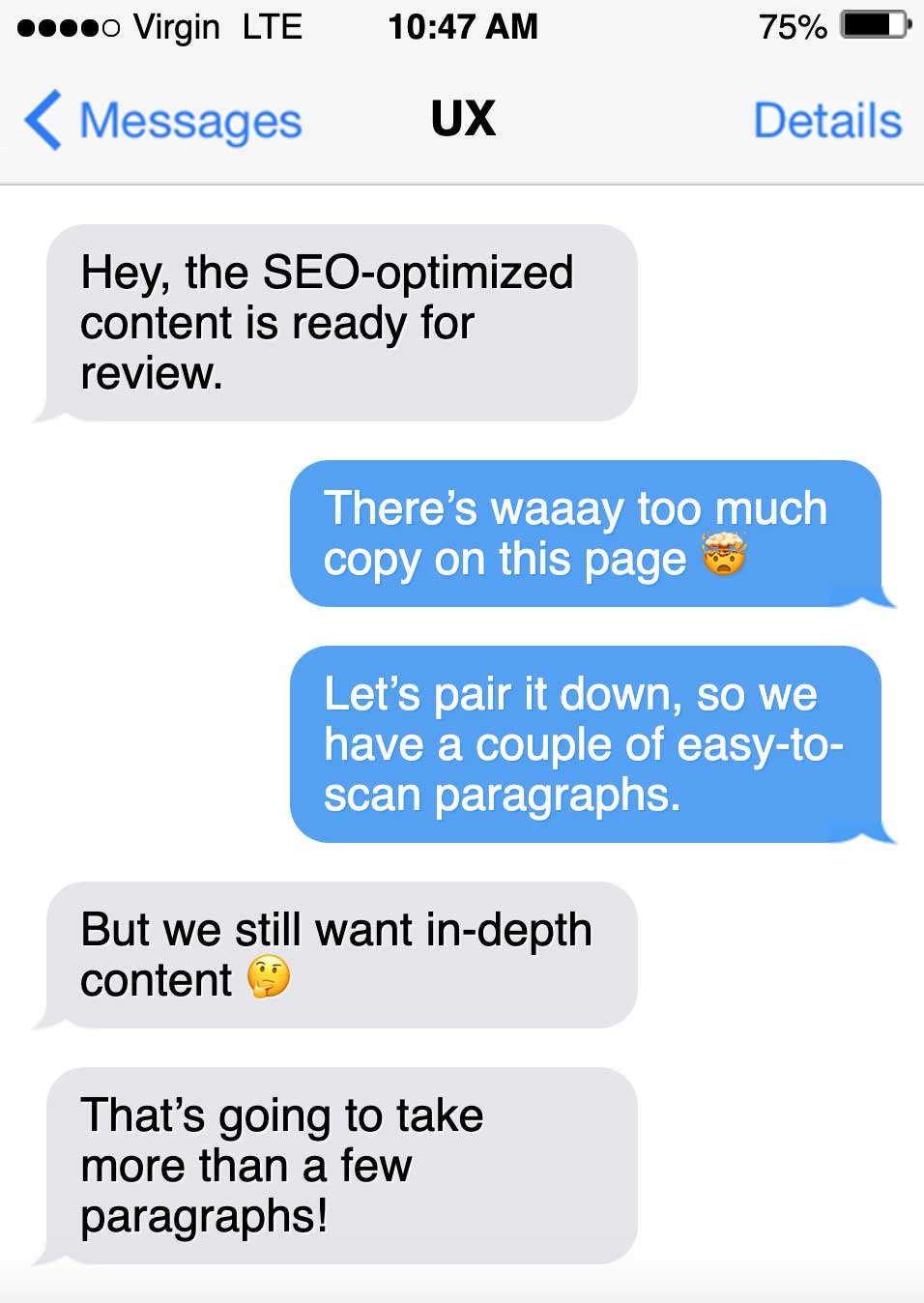In the digital marketing world, an epic battle has been going on for a while.
The combatants: SEO and UX (User Experience).
When designing landing pages, SEO and user experience goals and considerations are sometimes at odds. Here at Konstruct, we’re in the midst of this battle too. A typical team conversation (totally hypothetical, of course) could look something like this.

Yes, this is the ongoing tug-of-war between SEOs and UXers, but perhaps it’s time for an armistice? Lately, there has been a lot of discussion of how UX impacts SEO, so let’s explore whether the war between SEO and UX can finally end.
SEO Vs. UX

First, some introductions.
SEO
Fighting out of the red corner: search engine optimization (SEO).
The goal of SEO is to provide in-depth, relevant content that answers a user’s query about a targeted topic. This tactic is designed to make the page rank better on search engines, so it can attract more prospective customers.
Of course, content is only one factor to boost SEO, there are many other elements, including technical SEO, that play in. More about those later…
UX
Fighting out of the blue corner: user experience (UX).
Although UX is a bit of a fuzzy concept, at its core, the goal is to make it as easy as possible for the user to navigate through the page and find what they need. UX focuses on offering the user a valuable resource and can help support conversions on the site (let’s not get started on conversion-rate optimization or CRO, though!).
To simplify things, you could say that SEO is all about making search engines happy whereas UX is focused on delighting the human user. Sometimes, these target audiences are looking for the same things, sometimes not. This is, of course, a bit of an oversimplification, but might help you understand the seeds of conflict for this epic battle between SEO and UX.
Yup, UX Matters for SEO Too!

Whether UX is a ranking factor and to what degree has long been a source of debate among SEOs.
In May 2020, Google put this debate to rest when it announced that UX will become a considerable ranking factor in an upcoming Google algorithm change. However, Google didn’t give a timeline for when this Search ranking change will be rolled out but hinted at a launch sometime in 2021 – and promised a 6-month notice!
Here’s what Google has to say about the future of SEO and UX: “A good page experience doesn’t override having great, relevant content. However, in cases where there are multiple pages that have similar content, page experience becomes much more important for visibility in Search.” (Google Webmaster Central Blog)
In other words, in order for your page to stay competitive, UX is another factor that should be taken into consideration as part of SEO. How about that? Perhaps, UX and SEO are no longer at odds, but UX could now be considered a subcategory of SEO.
In the context of Google’s announcement, what are the UX metrics Google will be looking for to help determine how a page will rank?
Google and User Experience

Let’s go a little detour here – it’ll be worth it! Web Vitals is a new Google initiative that covers a wide range of tools to measure the quality of a user’s experience on a site.
Google recommends that site owners at a minimum, monitor and optimize the following “Core Web Vitals”:
- Loading. Google uses First Contentful Paint (FCP) to measure the load speed of a site. FCP is the time from when the page first starts loading until the visitor can see everything on the screen. According to Google, FCP should be less than 2.5 seconds.
- Interactivity. First Input Delay measures how responsive a page is, more specifically, the time from when a user interacts with an element such as clicks on a button to the time when the browser is able to process the response to the user interaction. According to Google, First Input Delay should be less than 100 milliseconds
- Visual Stability. Cumulative Shift Layout (CSL) measures how many times a user experiences unexpected layout shifts on a site – you know, when you’re reading through a page and it suddenly shifts and you lose your place. According to Google, your CLS score should ideally be below 0.1. If you want to get ultra-nerdy and learn how a CLS score is calculated, check out this article from Google’s developer blog.
Thankfully, Google has made it easy to quickly get an overview of your site’s performance in the 3 Core Web Vitals categories via their Chrome User Experience Report. Of course, you can also access this data via Google Search Console or any of the many other manual tools available.
Technical SEO & UX Elements

Ok, so you may have noticed that these UX metrics focus on technical elements on a site.
While it’s great that Google is clarifying which specific technical UX metrics it is taken into consideration when ranking a site, it’s not exactly a new phenomenon to review technical elements as part of an SEO audit. As mentioned earlier, technical SEO reviews and optimizes many different elements (including site speed), so adding these metrics to the list doesn’t revolutionize SEO best practices.
What IS different is the shift in focus from optimizing for search engines towards the human user. At the end of the day, Google is in the business of providing users with the information they’re looking for as quickly and easily as possible. Incorporating UX elements into ranking factors is a way to ensure sites are rewarded for providing visitors with a great experience.
How big of an impact will this next UX-focused algorithm update have on SEO is anyone’s guess. However, technical SEO has become more important than ever. Ignore it at your own peril!
Content is Still King

We’ve focused a lot on technical SEO so far, so let’s turn our attention to content and how the words on your page affect the user experience.
As mentioned earlier, Google still places a big emphasis on the actual content on your site. In Google’s words, “great, relevant content.” Let’s dive into what this means.
Relevant Content
Let’s address the relevancy aspect first. In the context of a search engine, SEO is centred around anticipating what information a user is looking for when making a query. Then, proving comprehensive, in-depth content that answers that question is useful because a search engine can offer this content as a solution/answer to a specific query.
Great Content
This one is a bit more tricky. When dissecting what great content means, we venture into the murky territory of subjectiveness. We all have different preferences when it comes to writing style and layout. As it turns out, there is a way to quantify the subjective… sort of.
Dwell Time

Dwell time is a metric that looks at the users’ time spent on a page. If many users spend a lot of time on your page, it’s a signal to Google that users:
- Find valuable content on your page.
- That the visitors enjoy your page content – or it’s at least not presented, written, or structured, so visitors are immediately turned off.
In its own way, dwell time can be used to measure whether the page content (along with other factors, of course) is ‘great’.
Dwell time is another one of those unicorn metrics that has been the subject of much debate over the years. We know that other search engines such as Bing uses dwell time as a ranking factor. We also know that Google measures dwell time but has never made an official statement regarding dwell time as a ranking factor (it’s come close, though…). However, there are indicators that dwell time might be taken into consideration when ranking a page. For example, studies by Moz, SEMRush, and Backlinko have all found a correlation between dwell time and page ranking.
Apart from hardcore ranking factors, there are probably many other reasons why you’d care about keeping your bounce rate low and the time spent on your site high. After all, you probably have goals that focus on capturing your target audience’s attention and focusing it on taking action in one form or another.
SEO + UX = 💚

SEO and UX have become BFFs! In fact, it’s now critical to merge SEO and UX considerations when writing landing page SEO copy, designing the page, and making technical improvements on a site.
Ultimately, in order to be successful, your site content should be a hit for both search engines and human visitors. When it comes to the page content, remember that providing comprehensive, relevant content is still at the core of SEO writing. However, that doesn’t mean that it shouldn’t be user-friendly and engaging.
Here’s a couple of tips you can consider when developing your copy for that winning SEO-UX combo.
- Break it up! Ahugewall of text will send your reader running for the hills. Instead, break your copy up into topical clusters and incorporate lists
- Headings, headings, headings… Headings are your friend. Not only do they help structure your content logically, but it also makes your content more scannable, so users can easily find the information they need, and search engines get more information about your content.
- Be Engaging. Is your content enjoyable to read? Does it surprise and hook the reader? Is it thought-provoking and relevant? What exactly that looks like will depend on your page topic and audience, but commonalities include good grammar, sentence and paragraph variation, and some creativity.
Thankfully, we’ve come a long way since the SEO was equivalent to keyword stuffing. In order to become successful and remain competitive in search rankings, you need to provide your visitor with both valuable content and a great experience.
Cue SEO and UX walking off into the sunset together!
Rank Better with SEO & UX
Now, that we’ve established a harmonious relationship between SEO and UX, you might be wondering how you can incorporate these new landing page SEO best practices.
If you’re struggling with ranking well, our team of SEO experts can help you design an effective strategy to climb and maintain search rankings – all while taking UX into consideration.
Get started with a free SEO audit or read more on our SEO services page.
Need help with B2B Content?
Learn more about Konstruct's B2B Content Services
More B2B Content Resources
- Should You Replace Your Content Marketer with AI? Maybe…
- LinkedIn B2B Marketing Examples That Made Us Say, “$h!t, I wish I thought of that!”
- 9 B2B Social Media Dos and Don’ts That’ll Change Your Social Game
- Stop Snoozing on These 7 B2B Content Marketing Trends
- B2B Marketing Copywriting: 10 Tips for Writing Persuasive Copy for Today’s B2B Buyers
- 9 Wow-Worthy B2B Content Marketing Examples To Inspire Your Content Strategy
- 8 Irrefutable B2B Social Media Marketing Benefits
- The Proven Formula for a Rock-Solid LinkedIn Content Strategy
- Content Marketing Statistics: The Facts You Can’t Afford to Ignore
- 999,999 Tips for Creating On-Brand SEO Content


